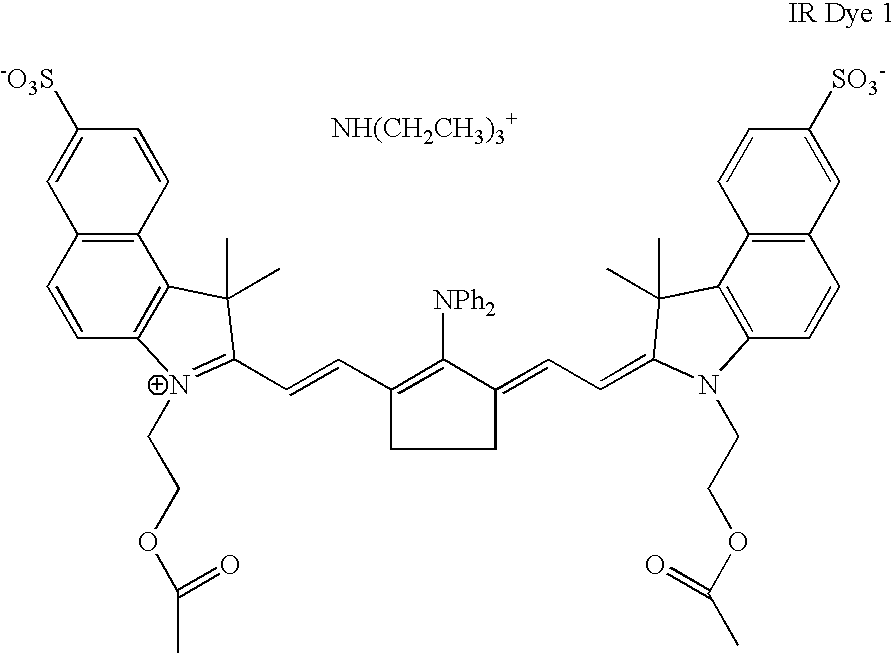Negative-working radiation-sensitive compositions and imageable materials
a radiation-sensitive composition and composition technology, applied in the field of negative-working radiation-sensitive compositions and imageable elements, can solve the problems of loss of digital speed, failure to eliminate this preheat step, etc., and achieve the effects of high imaging sensitivity, good printability, and fast digital speed
- Summary
- Abstract
- Description
- Claims
- Application Information
AI Technical Summary
Benefits of technology
Problems solved by technology
Method used
Image
Examples
synthetic example 1
Preparation of Monomer A, [3-(methacryloylamino)propyl]trimethylammonium tetraphenylborate
[0162]Sodium tetraphenylborate (13.68 g, Aldrich Chemical Co.) was dissolved in 300 g of water in a 500 ml beaker marked as Container A. [3-(Methacryloylamino)propyl]trimethylammonium chloride (17,64 g, 50% in water, Aldrich Chemical Co.) was diluted in 500 g of water in a 1000 ml beaker marked as Container B. The solution in Container A was slowly (over about 10 minutes) added to the solution in Container B while severely stirring by a Silverson L4R. A white precipitate was formed and the mixture was stored in a refrigerator for 2 hours. After a first filtration, the white solid was collected and washed with 100 ml of water. The product was obtained from a second filtration and dried under ambient temperature over the weekend and then at 35° C. in an oven for 4 hours to provide 20 g of a white solid.
synthetic example 2
Preparation of Polymer A
[0163]AlBN (1.6 g), methyl methacrylate (20 g), acrylonitrile (24 g), vinyl carbazole (18 g, from Polymer Dajac), methacrylic acid (18 g), and DMAC (320 g) were placed in a 1000-ml 3-necked flask, equipped with magnetic stirring, temperature controller, and N2 inlet. The mixture was heated to 60° C. and stirred under N2 protection overnight (about 16 hours). The % non-volatiles were measured at about 20%. The nitrogen protection was removed, and 5.2 g of KOH in 40 g of water were added. A viscous liquid was formed. After stirring the mixture for 10 minutes, 13.3 g of allyl bromide was added and the mixture was stirred at 55° C. for 3 hours. A 36% solution of HCl (12 g) in 40 g of DMAC was added to the flask and stirred for another 3 hours. The reaction mixture was filtered to remove inorganic salt formed. The filtrate was then slowly dropped to a mixture of 12 liters of water with 20 g of the 36% HCl solution while stirring. The resulting precipitate was filt...
synthetic example 3
Preparation of Polymer B
[0164]AlBN (0.8 g), Monomer A (5 g) from Synthetic Example 1, methyl methacrylate (8.4 g), acrylonitrile (10 g), vinyl carbazole (7.6 g, from Polymer Dajac), methacrylic acid (9 g), and DMAC (160 g) were placed in a 500-ml 3-necked flask, equipped with magnetic stirring, temperature controller, and N2 inlet. The mixture was heated to 60° C. and stirred under N2 protection overnight (about 16 hours). The % non-volatiles were measured at about 20%. The nitrogen protection was removed, and 2.6 g of KOH in 20 g of water were added. A viscous liquid was formed. After stirring the mixture for 10 minutes, 6.65 g of allyl bromide was added and the mixture was stirred at 55° C. for 3 hours. A 36% HCl solution (6 g) in 20 g of DMAC was added to the flask and stirred for another 3 hours. The reaction mixture was filtered to remove inorganic salt that had formed. The filtrate was then slowly dropped into a mixture of 6 liters of water with 10 g of 36% HCl solution with s...
PUM
| Property | Measurement | Unit |
|---|---|---|
| weight % | aaaaa | aaaaa |
| wavelength | aaaaa | aaaaa |
| wavelength | aaaaa | aaaaa |
Abstract
Description
Claims
Application Information
 Login to View More
Login to View More - R&D
- Intellectual Property
- Life Sciences
- Materials
- Tech Scout
- Unparalleled Data Quality
- Higher Quality Content
- 60% Fewer Hallucinations
Browse by: Latest US Patents, China's latest patents, Technical Efficacy Thesaurus, Application Domain, Technology Topic, Popular Technical Reports.
© 2025 PatSnap. All rights reserved.Legal|Privacy policy|Modern Slavery Act Transparency Statement|Sitemap|About US| Contact US: help@patsnap.com



